It’s Day 28 for The Kasturi/Files here at Speculative Chic! Only a few more days til the great spook-show that is Halloween! We bring you more movie talk, book recs, and delightful things to sip from Sandra Kasturi and Gemma Files.
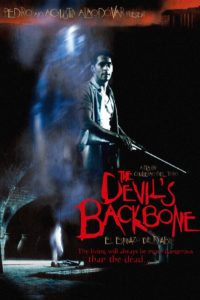 Gemma: Mexican writer-director/internationally notorious monsterfucker apologist (cf. The Shape of Water — SK) Guillermo del Toro’s The Devil’s Backbone (2001) begins with a voice-over that’s since essentially become his gothic horror thesis statement:
Gemma: Mexican writer-director/internationally notorious monsterfucker apologist (cf. The Shape of Water — SK) Guillermo del Toro’s The Devil’s Backbone (2001) begins with a voice-over that’s since essentially become his gothic horror thesis statement:
“What is a ghost? A tragedy condemned to repeat itself time and again? An instant of pain, perhaps. Something dead which still seems to be alive. An emotion suspended in time. Like a blurred photograph. Like an insect trapped in amber.”
Sandra: One of the things I am consistently amused by during this process of writing these back-and-forth film discussions is how often we fasten on the same things to talk about. For those of you who don’t know, Gemma and I don’t live in the same city anymore, so we’ve been doing this entirely by email, and to save time, we just write our own bits about the movie in question and then there’s a bit of back and forth, and then the amalgamation. I can’t tell you how many times I’ve had to delete parts of each of our work because we are talking about the same things! And often in the same way. It makes for simpatico discussion, that’s for sure.
Which is to say that I too was mesmerized by the short opening monologue in the film, which, yes, is del Toro’s horror film thesis statement, but to me reads like a tone poem that encapsulates the whole story. Actually, the movie itself feels like an elegant piece of formal verse, a melancholy sonnet, complete with a reversal in the final couplet. Or perhaps an opera, full of blood and froth, tragic but beautiful.
Gemma: We really are on the same page most of the time. Except about Prometheus.
Sandra: Let’s not talk about Prometheus!
Gemma: The person speaking those opening words is Doctor Casares (Federico Luppi, star of del Toro’s 1993 debut feature Cronos, a typically weird vampire tale involving a life-extending machine made by an evil alchemist and powered by an undying insect), and the year is 1939; the Spanish Civil War is finally entering its end-stages, a state of affairs particularly pertinent for Casares and his fellow intellectual Senora Carmen (Marisa Paredes), who operate a small orphanage in a remote area of Spain that has no problem taking in children left homeless on either side of the conflict.
One of these kids, Carlos (Fernando Tielve), is dropped off at the home by two Republican soldiers engaged in fighting the forces of General Franco who tell Casares and Carmen that Carlos’s father was killed by the Fascists recently. Though no one ever actually gets around to telling Carlos this, he’s very much aware that it’s a foregone conclusion that no one’s probably coming back for him; he’s a kid, but he’s not dumb. Luckily, however — for certain values of luck — the home turns out to be full of welcome distractions from this distressing train of thought: an unexploded bomb half-buried in the orphanage’s courtyard, potentially ticking down to explosion; a creepily handsome former student turned caretaker, Jacinto (Eduardo Noriega), who broods around the place doing odd jobs for Casares and Carmen while bullying the “new kids” any chance he gets; and, best of all . . . a ghost.
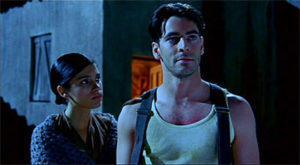 Sandra: I love the metaphorical and literal aspects of the unexploded bomb — it’s a great visual representation of suspended time, and ties into the idea of ghosts being “insects in amber.” The orphanage itself is a held breath, waiting for something to happen — most likely for Franco’s Nationalist Army to arrive and shoot them all. They are waiting for the world to end, living in a moment that is waiting to happen. Maybe that’s what a ghost is as well: a moment still waiting to happen, waiting for the right trigger: who will turn out to be Carlos — the representation of innocence, but also a catalyst. (And good gawd, that Jacinto is a piece of shit.)
Sandra: I love the metaphorical and literal aspects of the unexploded bomb — it’s a great visual representation of suspended time, and ties into the idea of ghosts being “insects in amber.” The orphanage itself is a held breath, waiting for something to happen — most likely for Franco’s Nationalist Army to arrive and shoot them all. They are waiting for the world to end, living in a moment that is waiting to happen. Maybe that’s what a ghost is as well: a moment still waiting to happen, waiting for the right trigger: who will turn out to be Carlos — the representation of innocence, but also a catalyst. (And good gawd, that Jacinto is a piece of shit.)
Gemma: Talking to Mark Kermode about the vibrant darkness of his distinctive worldview back in 2006, Mexican maestro Guillermo del Toro cited a phrase from “The Skins of the Fathers,” a short story by Clive Barker: “The line refers to a feeling which stirs ‘deep in her, in a place touched only by monsters.’ And I really think that the most creative, most fragile part of the child that lives within me is a child that was literally transformed by monsters. Be they on the screen or in myth or in my own imagination.” He’s spoken cheerfully about how monsters — Frankenstein’s creation and the Creature from the Black Lagoon, specifically — “saved his life,” especially during the period of it when he lived with his loving, worried, and extremely Catholic grandmother, who had him exorcised more than once because of his Goth tendencies. But is a ghost really a monster, per se? That question forms the grit around which The Devil’s Backbone‘s blackly shimmering pearl organizes itself.
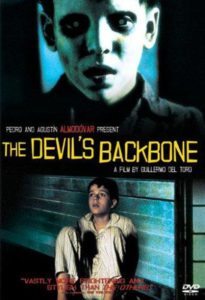 Sandra: Speaking of his love of monsters, when del Toro wrote The Strain books with Chuck Hogan and was interviewed about them, he stated that he wanted his vampires to be “less of a date and more of a monster.” You could see his impatience with Twilight and its ilk, which is amusing given The Shape of Water years later. Well, I suppose the creature there isn’t really a monster; he just looks like one to us at first.
Sandra: Speaking of his love of monsters, when del Toro wrote The Strain books with Chuck Hogan and was interviewed about them, he stated that he wanted his vampires to be “less of a date and more of a monster.” You could see his impatience with Twilight and its ilk, which is amusing given The Shape of Water years later. Well, I suppose the creature there isn’t really a monster; he just looks like one to us at first.
Gemma: Part of what I love best about Tio Guillermo (as some horror fans refer to him) is the way he automatically uses whatever fascinates him most as grist for his mill. His obsession with the Spanish Civil War, apparently stemming from family stories about the time period, produced not just The Devil’s Backbone but also Pan’s Labyrinth, considered by many to be his masterpiece — and both films share a lot of narrative/thematic DNA, reading in part like dark fairy tales told by people trying to process the cultural and political trauma of their past; the supernatural stands either in opposition to or simply in for the “merely” natural, true human evil, which is always far more discomforting to contemplate.
Sandra: Those two movies share enough DNA that I had actually conflated them in my head, braided them into a single whole new narrative, and literally could no longer remember which things belonged in which movie. Except for some very obvious visuals, like: monster with eyes in his palms? Yeah, Pan’s Labyrinth. Watery child ghost? Yeah, Devil’s Backbone. I also managed to throw bits of The Orphanage in there, creating a giant hodgepodge of gothic spookiness, so I had to re-watch to sort out the whole tangled mess. (Or keep asking Gemma things like, “Was the bomb in Pan? Or Backbone? Or both?” Bananas!)
Gemma: In Pan’s Labyrinth, human evil rears its head in the persona of Captain Vidal, devout Fascist stepfather to that film’s protagonist, Ofelia — he wants to crush her tendencies towards fantasy, believing them useless and deviant. In The Devil’s Backbone, meanwhile, it’s Jacinto who embodies the true human evil of the War itself — a young man who’s never known anything but conflict and predation, betrayal of ideals, lies and exploitation. Noriega plays him brilliantly, inserting touches here and there that seem to imply he’s an abuse survivor, amongst them his unsettling use of his own sexual attractiveness, as he coldly romances both Carmen — older than him, mournfully loved from afar by Doctor Casares and in constant pain from the stump of her prosthetic leg — and any girl his age he comes across. For Jacinto, every relationship is transactional at best, and if the home’s founders ever tried to teach him better than that, they must both be aware they failed utterly. But what are they going to do about it, especially now that everything is on the verge of falling apart? Nothing, according to Jacinto, his beautiful face deformed by a near-constant sneer; he makes it very clear he thinks they’re too weak to do anything, book-smart but street-stupid, in love with ridiculous ideals which will eventually kill them. And as Carlos knows, he’s probably not wrong.
Sandra: Near the end of the movie, Carlos picks up a bright red (fairy-tale!) apple, which looks delicious, but when he’s turned it over, he sees it’s started to rot — a perfect visual representation of the festering nastiness in Jacinto, masked by his gorgeous exterior. And a great metaphor for Fascist Spain itself, and Nazi Europe to come, as at this point in the narrative, World War II is only months away. As Casares says, “Europe is sick with fear now and fear sickens the soul. And that, in turn, makes us see things.” Fear as the mother of the supernatural.

Gemma: So there are two ghosts haunting The Devil’s Backbone, pretty much throughout. One is literal: Santi, the figure Carlos keeps glimpsing out of the corner of his eye, blood from his shattered skull always twisting upward to dissolve into darkness, as if he’s constantly immersed in invisible water — an amazing achievement even for del Toro, who designs his own visuals by collating inspirations from sources as apparently unrelated as M.R. James’s superbly British ghostly tales on the one hand and the Spanish graphic-novel series Paracuellos, by Carlos Giménez (who worked as a storyboard artist on the film), on the other. The second spirit, however, is the metaphorical ghost of the “free Spain” Carlos’s father fought and died for, a place where brute force and hunger aren’t the most powerful societal drives, a place where there might actually be a little room left over for sentiment, for imagination, for poetry like these painfully beautiful lines Doctor Casares quotes from Luz Hanaii, acknowledging he understands exactly why his decrepit love can’t be enough for Carmen:
“Stay by my side as my light grows dim / as my blood slows down and my nerves shatter with stabbing pain / as my heart grows weak / and the wheels of my being turn slowly / Stay by my side /as my fragile body is racked by pain /which verges on truth / and manic time continues scattering dust / and furious life bursts out in flames. Stay by my side / as I fade / so you can point to the end of my struggle /and the twilight of eternal days / at the low, dark edge of life.”
Sandra: Here, again, I wrote down those very lines myself to talk about! This film is about that “low, dark edge of life” if it’s about anything. And that leaking head wound of Santi’s . . . ah! how del Toro excels at that juxtaposition of beauty and horror! That endless flowing red, trailing like a bright scarf from the dead boy’s head. It’s visually stunning and absolutely horrific. Even the way that ghosts move, with bits seeming to flake off, and move with them in an eye-straining, cortex-disturbing way, is a lovely effect. It’s interesting how del Toro moves from the sublime to the grotesque, even in a horror movie: from that red ribbon wound, to the pickled babies with spina bifida in jars: the titular devil’s backbone, floating in an admixture of rum and spices — sold to the people of the nearby town to cure any number of ailments, including impotence. The devil’s backbone: “nobody’s children.” And that’s who all the orphan boys in the film are too, lost souls whom no one is left to care about, waiting on the threshold of a future that might never come, or be too awful to even contemplate.
As the movie concludes, Doctor Casares repeats the words from the beginning, bringing it full circle. “What is a ghost?” But he adds at the end: “A ghost. That’s what I am.” The Devil’s Backbone is a melancholy masterpiece, a period ghost story that nevertheless resonates even now. Maybe especially now. Aren’t we perhaps in the same boat, as “manic time continues scattering dust”?
Cocktail: Red Ribbon
Sandra: Speaking of red ribbons, here’s a beautiful cocktail. Perhaps you shouldn’t think about gaping head wounds while drinking. Or maybe you should? Halloween is coming after all. This one is a bit like an Aperol Spritz.
 Ingredients:
Ingredients:
- 1 tbsp Aperol or Campari
- 3 tbsp blood orange juice (fresh or bottled)
- dash orange bitters
- sparkling wine or champagne
- orange slice
Directions:
Throw first three ingredients in a shaker with ice; strain into a glass. Top with sparkling wine and garnish with the orange slice.
So pretty! Sip gently while taking a break from your weekly schedule of exorcisms.
Book Recommendations
Gemma: I’d recommend Carmen Maria Machado’s collection, Her Body and Other Parties. Also Silvia Moreno-Garcia’s Signal to Noise and the recently released Gods of Jade and Shadow.
Sandra: I think I’ll recommend Caitlin Sweet’s The Pattern Scars, which is more mythology than fairy tale, and more Greek Tragedy than ghost story, but it has a similarly relentless tragic narrative, and is beautiful and melancholy. So it fits flavor-wise. I also strongly recommend Gemma’s two authors!
 Sandra Kasturi is the publisher of ChiZine Publications, winner of the World Fantasy, British Fantasy, and HWA Specialty Press Awards. She is the co-founder of the Toronto SpecFic Colloquium and the Executive Director of the Chiaroscuro Reading Series, and a frequent guest speaker, workshop leader, and panelist at genre conventions. Sandra is also an award-winning poet and writer, with work appearing in various venues, including Amazing Stories, Black Feathers: Dark Avian Tales, Prairie Fire, several Tesseracts anthologies, Evolve, Chilling Tales, ARC Magazine, Taddle Creek, Abyss & Apex, Stamps, Vamps & Tramps, and 80! Memories & Reflections on Ursula K. Le Guin. She recently won the Sunburst Award for her short story, “The Beautiful Gears of Dying,” in the anthology The Sum of Us. Her two poetry collections are: The Animal Bridegroom (with an introduction by Neil Gaiman) and Come Late to the Love of Birds. Sandra is currently working on another poetry collection, Snake Handling for Beginners, a story collection, Mrs. Kong & Other Monsters, and a novel, Wrongness: A False Memoir. She is fond of red lipstick, gin & tonics, and Idris Elba.
Sandra Kasturi is the publisher of ChiZine Publications, winner of the World Fantasy, British Fantasy, and HWA Specialty Press Awards. She is the co-founder of the Toronto SpecFic Colloquium and the Executive Director of the Chiaroscuro Reading Series, and a frequent guest speaker, workshop leader, and panelist at genre conventions. Sandra is also an award-winning poet and writer, with work appearing in various venues, including Amazing Stories, Black Feathers: Dark Avian Tales, Prairie Fire, several Tesseracts anthologies, Evolve, Chilling Tales, ARC Magazine, Taddle Creek, Abyss & Apex, Stamps, Vamps & Tramps, and 80! Memories & Reflections on Ursula K. Le Guin. She recently won the Sunburst Award for her short story, “The Beautiful Gears of Dying,” in the anthology The Sum of Us. Her two poetry collections are: The Animal Bridegroom (with an introduction by Neil Gaiman) and Come Late to the Love of Birds. Sandra is currently working on another poetry collection, Snake Handling for Beginners, a story collection, Mrs. Kong & Other Monsters, and a novel, Wrongness: A False Memoir. She is fond of red lipstick, gin & tonics, and Idris Elba.
 Formerly a film critic, journalist, screenwriter and teacher, Gemma Files has been an award-winning horror author since 1999. She has published two collections of short work, two chap-books of speculative poetry, a Weird Western trilogy, a story-cycle and a stand-alone novel (Experimental Film, which won the 2016 Shirley Jackson Award for Best Novel and the 2016 Sunburst award for Best Adult Novel). Most are available from ChiZine Publications. She has two new story collections from Trepidatio (Spectral Evidence and Drawn Up From Deep Places), one upcoming from Cemetery Dance (Dark Is Better), and a new poetry collection from Aqueduct Press (Invocabulary).
Formerly a film critic, journalist, screenwriter and teacher, Gemma Files has been an award-winning horror author since 1999. She has published two collections of short work, two chap-books of speculative poetry, a Weird Western trilogy, a story-cycle and a stand-alone novel (Experimental Film, which won the 2016 Shirley Jackson Award for Best Novel and the 2016 Sunburst award for Best Adult Novel). Most are available from ChiZine Publications. She has two new story collections from Trepidatio (Spectral Evidence and Drawn Up From Deep Places), one upcoming from Cemetery Dance (Dark Is Better), and a new poetry collection from Aqueduct Press (Invocabulary).

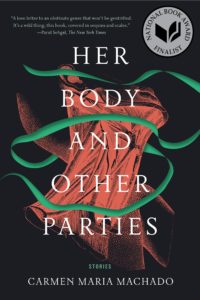
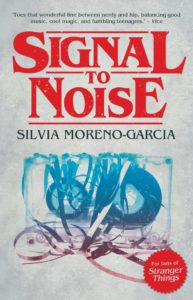
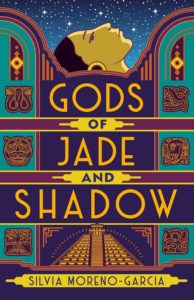
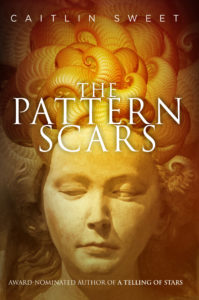
Not familiar with this one, but it sounds like I should check it out, especially with del Toro’s involvement!